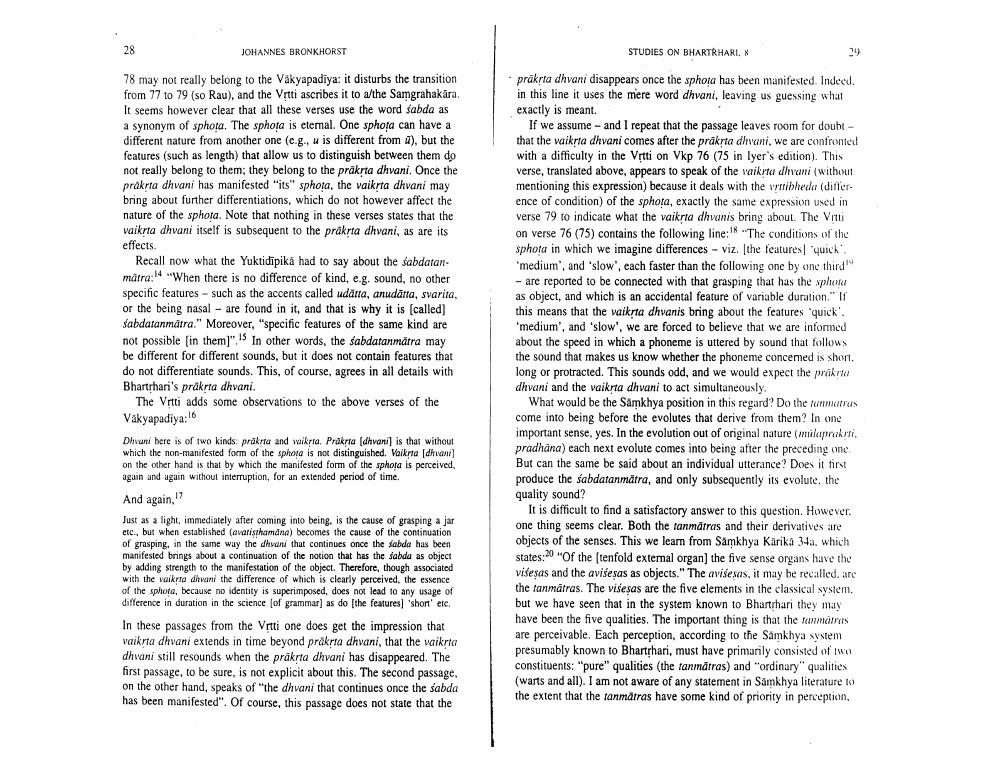________________
JOHANNES BRONKHORST
STUDIES ON BHARTRHARI, X
78 may not really belong to the Vakyapadiya: it disturbs the transition from 77 to 79 (so Rau), and the Vrtti ascribes it to a/the Samgrahakära, It seems however clear that all these verses use the word fabda as a synonym of sphota. The sphota is eternal. One sphoța can have a different nature from another one (c.g., u is different from a), but the features (such as length) that allow us to distinguish between them do not really belong to them; they belong to the prakta dhvani. Once the prakrta dhvani has manifested "its" sphota, the vaikyta dhvani may bring about further differentiations, which do not however affect the nature of the sphora. Note that nothing in these verses states that the vaikrta dhvani itself is subsequent to the prakrta dhvani, as are its effects.
Recall now what the Yuktidīpika had to say about the sabdatanmatra:14 "When there is no difference of kind, e.g. sound, no other specific features - such as the accents called udarta, anudārta, svarita, or the being nasal - are found in it, and that is why it is called) Sabdatanmārra." Moreover, "specific features of the same kind are not possible in them)"." In other words, the sabdatanmātra may be different for different sounds, but it does not contain features that do not differentiate sounds. This, of course, agrees in all details with Bharthari's präkrta dhvani.
The Vrtti adds some observations to the above verses of the Väkyapadiya:16 Dhvani here is of two kinds prākta and waikrta. Prakrta (dhvani] is that without which the non-manifested form of the sphola is not distinguished. Vaikrta (dhwani on the other hand is that by which the manifested form of the sphora is perceived, again and again without interruption, for an extended period of time.
prakrta dhvani disappears once the sphota has been manifested. Indeed. in this line it uses the mere word dhvani, leaving us guessing what exactly is meant.
If we assume - and I repeat that the passage leaves room for doubt - that the vaikrta dhvani comes after the prākta dhivani, we are confronted with a difficulty in the Vrtti on Vkp 76 (75 in lyer's edition). This verse, translated above, appears to speak of the vaikrta dhuni (without mentioning this expression) because it deals with the wrribheda (differ ence of condition) of the sphora, exactly the same expression used in verse 79 to indicate what the vaikria dhvanis bring about. The Vitli on verse 76 (75) contains the following line: "The conditions of the sphota in which we imagine differences - viz. the features quick 'medium', and 'slow', each faster than the following one by one third - are reported to be connected with that grasping that has the sphoru as object, and which is an accidental feature of variable duration." I this means that the vaiksta dhvanis bring about the features quick'. 'medium', and 'slow', we are forced to believe that we are informed about the speed in which a phoneme is uttered by sound that follows the sound that makes us know whether the phoneme concemed is short, long or protracted. This sounds odd, and we would expect the prikru dhvani and the vaikyta dhvani to act simultaneously
What would be the Samkhya position in this regard? Do the Turku come into being before the evolutes that derive from them? In one important sense, yes. In the evolution out of original nature (mulapukoti pradhana) each next evolute comes into being after the preceding one But can the same be said about an individual utterance? Does it first produce the sabdatanmätra, and only subsequently its evolute, the quality sound?
It is difficult to find a satisfactory answer to this question. However, one thing seems clear. Both the tanmatras and their derivatives are objects of the senses. This we learn from Samkhya Karika 34a, which states:20 "Of the (tenfold external organ) the five sense organs have the višesas and the aviseșas as objects." The avisesas, it may be recalled, are the tanmatras. The visesas are the five elements in the classical system. but we have seen that in the system known to Bharthari they may have been the five qualities. The important thing is that the fanmaires are perceivable. Each perception, according to the Samkhya system presumably known to Bharthari, must have primarily consisted of two constituents: "pure" qualities (the tanmārras) and "ordinary" qualities (warts and all). I am not aware of any statement in Samkhya literature to the extent that the tanmatras have some kind of priority in perception,
And again, 17
Just as a light, immediately after coming into being, is the cause of grasping a jar etc., but when established (avaristhamana) becomes the cause of the continuation of grasping, in the same way the dhvani that continues once the sabda has been manifested brings about a continuation of the notion that has the sabda as object by adding strength to the manifestation of the object. Therefore, though associated with the vaikrta divani the difference of which is clearly perceived, the essence of the sphora, because no identity is superimposed, does not lead to any usage of difference in duration in the science (of grammar) as do the features) 'short' etc.
In these passages from the Vrtti one does get the impression that vaikyta dhvani extends in time beyond prakrta dhvani, that the vaikrla dhvani still resounds when the prakrta dhvani has disappeared. The first passage, to be sure, is not explicit about this. The second passage, on the other hand, speaks of "the dhvani that continues once the sabda has been manifested". Of course, this passage does not state that the




